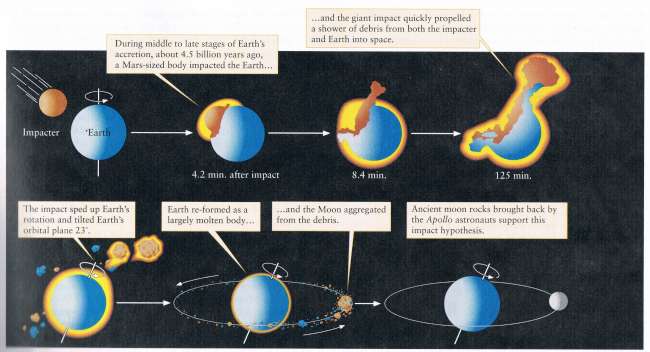
A new massive computer model that simulates the formation of the solar system from its early days when all it used to comprise was a huge disk of matter to present day shows that Earth’s moon formed some 65 million years later than previous estimates led us to believe. The method provides a new way to calculate the moon’s birthday, independent from physical analysis like radioactive decay.
The birth of the moon
The leading moon formation theory is that some 4.5 billion years ago a planetary body the size of Mars collided with the Early Earth. The lion’s share of the debris coalesced to form the Earth as it is today, while a portion of the Theia (the name of the planet which smashed into Earth) and early Earth mass joined to from the moon.
This theory was first conceived in 1946 by Reginald Aldworth Daly from Harvard University. This theory was first conceived in 1946 by Reginald Aldworth Daly from Harvard University. The impact theory explained many of the challenges about the formation of the Moon. For example, one question was: why do the Earth and Moon have very different-sized cores.
The new study aggregates 259 computer simulations and models the evolution of the solar system from its very first moments when all it comprised was a slew of embryonic planetary masses. For the first few millions of years, multiple crashes and merges occur some which led to the formation of Earth and the moon. Using this new geological time-frame, astronomers at the Carnegie Institution for Science in Washington DC found that the primordial impact that caused the Earth to lose its last big chunk occurred some 95 million years after the birth of the solar system. This means that the moon started forming up to 65 millions years later than previous estimates had positioned.
A history that starts 4.58 billion years ago

Previous estimates were based on telltale signs following measurements of the naturally occurring radioactive decay of key atoms found in lunar rocks.
The same process, however, also led to findings that the impact happened between 50 million and 100 million years after the solar system’s formation. The finding disputes, with a 99.9 percent degree of accuracy, some previous estimates that the moon-forming impact occurred as early as 30 million to 40 million years after the solar system’s formation, some 4.58 billion years ago.
“Our new method … is independent of radiometric techniques and so we break through the controversy,” lead researcher Seth Jacobson, with Cote d’Azur Observatory in Nice, France said.
The new findings raise some new questions, however. Mars, for instance, finished forming as a planet in just a few million years, according to the simulation, backed by physical analysis of martian meteorites. Why such a large discrepancy between Mars and Earth formation exists is a great puzzle for scientists at the moment.
The findings were reported in the journal Nature.






